酪蛋白中派生的自由基清除活性肽分离及鉴定
保加利亚乳杆菌水解酪蛋白的条件及自由基清除活性的研究
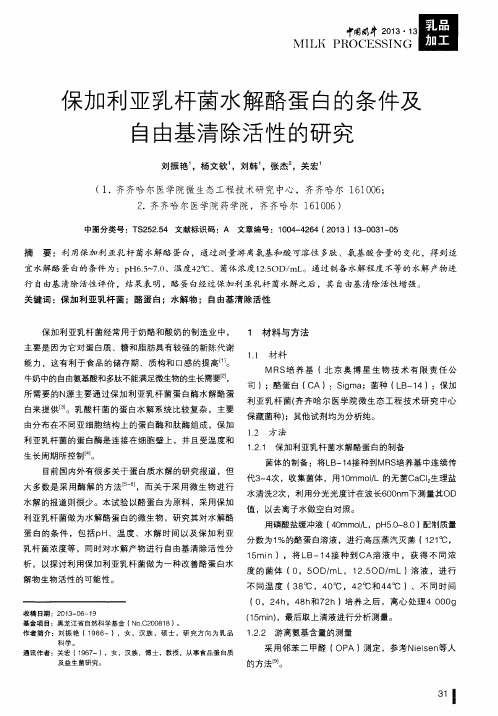
白来提供 】 。乳酸杆 菌的蛋 白水解系统 比较复杂 ,主要
由分 布 在 不 同亚 细胞 结 构 上 的蛋 白酶 和 肽 酶组 成 ,保 加 利亚 乳 杆菌 的蛋 白酶 是 连 接在 细胞 壁 上 ,并且 受 温度 和
生长 周期 所 控制 L 4 1 。
保藏菌种) ;其他试剂均为分析纯。
1 . 2 方 法
1 l 2 . 1 保 加利 亚乳 杆 菌水 解酪 蛋 白的制备 茵体 的制备 :将 L B 一 1 4 接 种到 MR S 培 养基 中连续 传 代3 — 4 次 ,收 集菌体 ,用 1 0 mmo } / L的 无菌 C a C I , 生理 盐
目前 国 内外 有很 多关于 蛋 白质水 解 的研 究 报 道 ,但 大 多数 是 采 用 酶 解 的 方 法 _ 5 】 ,而 关于 采 用 微 生 物 进 行
水清洗2 次 ,利用分光光度计在波长6 0 0 n m下测量其O D
值 ,以去离 子水 做 空 白对照 。 用磷酸盐缓 冲液 ( 4 0 m mo l / L ,p H 5 . 0 ~ 8 . 0) 配制质 量 分数 为 1 %的酪 蛋 白溶 液 ,进 行高 压 蒸汽 灭菌 ( 1 2 1 ℃, 1 5 mi n),将 L B 一 1 4 接 种 到 CA 溶 液 中 ,获 得 不 同 浓
例
3
MI LK PROCE S SI N
G 田 ●
3
保 加利亚乳杆菌水解酪蛋 白的条件及
自由基 清 除活性 的研究
刘振艳’ ,杨 文钦’ ,刘韩 ’ ,张杰 ,关宏’
( 1 .齐齐哈尔 医学院微生态工程技术研 究中心 ,齐齐哈 尔 l 6 1 0 0 6 ; 2 .齐齐哈尔 医学院药学院 ,齐齐哈尔 1 6 1 0 0 6 )
DPPH和ABTS、PTIO自由基清除实验-操作图解-李熙灿-Xican-Li
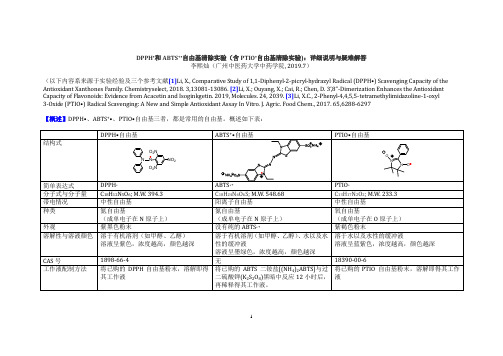
DPPH•和ABTS+•自由基清除实验(含PTIO•自由基清除实验):详细说明与疑难解答李熙灿(广州中医药大学中药学院, 2019.7)(以下内容系来源于实验经验及三个参考文献[1]Li, X., Comparative Study of 1,1-Diphenyl-2-picryl-hydrazyl Radical (DPPH•) Scavenging Capacity of the Antioxidant Xanthones Family. Chemistryselect, 2018. 3,13081-13086. [2]Li, X.; Ouyang, X.; Cai, R.; Chen, D. 3’,8”-Dimerization Enhances the Antioxidant Capacity of Flavonoids: Evid ence from Acacetin and Isoginkgetin. 2019, Molecules. 24, 2039. [3]Li, X.C., 2-Phenyl-4,4,5,5-tetramethylimidazoline-1-oxyl3-Oxid e (PTIO•) Radical Scavenging: A New and Simpl e Antioxidant Assay In Vitro. J. Agric. Food Chem., 2017. 65,6288-6297【概述】DPPH•、ABTS+•、PTIO•自由基三者,都是常用的自由基。
概述如下表:12工作液外观紫色墨绿色蓝紫色工作液紫外光谱与最大吸收2004006008000.00.51.01.52.02.53.0吸光度波长/nm519nm(50 μg/mL)2003004005006007008009000.00.51.01.52.0734nm吸光度波长/nm415nm(0.07mM (NH 4)2ABTS+0.03mM K 2S 2O 8)200400600800012吸光度波长/nm557nm(50 μg/mL)检测波长 519 nm 734nm557nm (水溶液)检测原理当A 519 nm 值减少,表明DPPH·被清除。
奶粉中酪蛋白磷酸肽的作用及功能
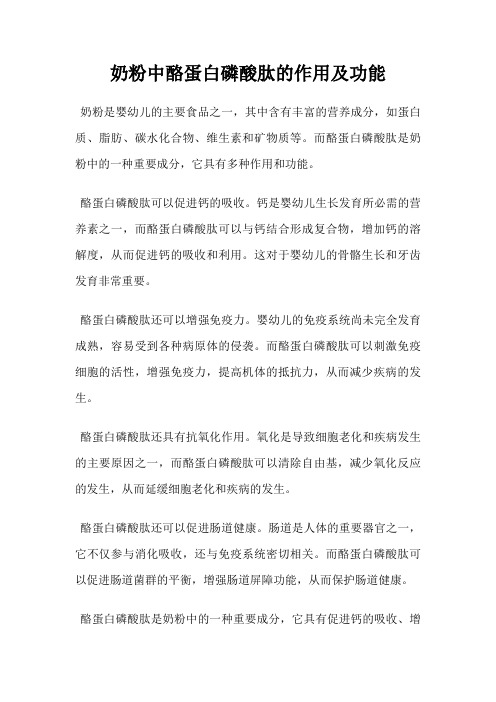
奶粉中酪蛋白磷酸肽的作用及功能
奶粉是婴幼儿的主要食品之一,其中含有丰富的营养成分,如蛋白质、脂肪、碳水化合物、维生素和矿物质等。
而酪蛋白磷酸肽是奶粉中的一种重要成分,它具有多种作用和功能。
酪蛋白磷酸肽可以促进钙的吸收。
钙是婴幼儿生长发育所必需的营养素之一,而酪蛋白磷酸肽可以与钙结合形成复合物,增加钙的溶解度,从而促进钙的吸收和利用。
这对于婴幼儿的骨骼生长和牙齿发育非常重要。
酪蛋白磷酸肽还可以增强免疫力。
婴幼儿的免疫系统尚未完全发育成熟,容易受到各种病原体的侵袭。
而酪蛋白磷酸肽可以刺激免疫细胞的活性,增强免疫力,提高机体的抵抗力,从而减少疾病的发生。
酪蛋白磷酸肽还具有抗氧化作用。
氧化是导致细胞老化和疾病发生的主要原因之一,而酪蛋白磷酸肽可以清除自由基,减少氧化反应的发生,从而延缓细胞老化和疾病的发生。
酪蛋白磷酸肽还可以促进肠道健康。
肠道是人体的重要器官之一,它不仅参与消化吸收,还与免疫系统密切相关。
而酪蛋白磷酸肽可以促进肠道菌群的平衡,增强肠道屏障功能,从而保护肠道健康。
酪蛋白磷酸肽是奶粉中的一种重要成分,它具有促进钙的吸收、增
强免疫力、抗氧化和促进肠道健康等多种作用和功能。
因此,在选择奶粉时,应该注重酪蛋白磷酸肽的含量和质量,以保证婴幼儿的健康成长。
活性多肽及其加工技术
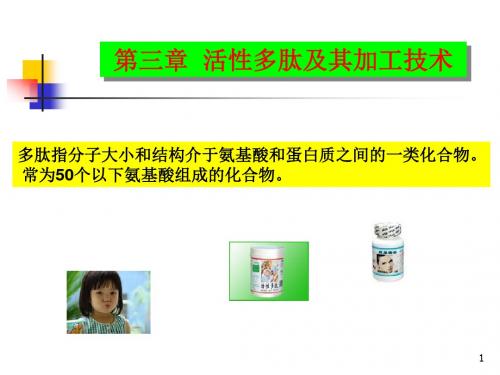
(1)原料:植物种子胚芽、动物内脏、 酵母,以酵母作为原料居多。
(2)萃取:关键是使谷胱甘肽从细胞中释放出来。 ①酶溶解法 ②化学抽提法③机械破碎法
球 磨 机
均质机
27
4.工艺说明
(3)分离:铜盐法沉淀分离 (5)水洗:用清水洗滤渣至无硫酸根离子 (6)脱盐:通入H2S除去铜离子,再通入H2或N2排去H2S (7)浓缩:蒸馏法浓缩滤液 (8)干燥: 喷雾干燥法、冷冻干燥法或电热真空干燥
氧化型谷胱甘肽(GSSG)
特殊结构: N末端肽键由谷氨酸的γ-羧基和 半胱氨酸的氨基构成,使得它在细胞内稳定。
巯基是GSH发挥生物学功能所必需的。
17
(二)谷胱甘肽的生理功能及作用机理
1.清除自由基作用 2.参与解毒作用
3.维持红细胞的完整性
4.保护肝细胞、促进肝功能作用
5. 参与人体内代谢调节作用
38
(二)提取法
1.原理:硫酸铵盐析沉淀多肽,然后超滤获得所需多肽 2.设备:离心机、离子交换设备、超滤机 3.工艺流程
收集发酵液→离心→上清液沉淀→离心→脱色→超滤→干燥→成品
39
4.工艺说明
(1)离心:发酵液离心分离 (2)沉淀:硫酸铵盐析沉淀多肽 (3)脱色:DEAE-Sephacel (二乙氨乙基葡聚糖纤维素阴离子交换层析柱) (4)超滤:截留相对分子质量3000的中空纤维超滤
42
三、降血压肽在功能食品中的应用
日本:沙丁鱼肽、玉米多肽混合物“缩氨酸”
我国:暂无产品上市
43
本章总结
一
核心结构:成串的磷酸丝氨酸和谷氨酸簇
酪
蛋 白
主要功能:促进钙吸收
磷
酸
制备:先酶解,再沉淀或离子交换得到多肽
酪蛋白-木糖体系美拉德反应产物的抗氧化活性

年 第 卷 第 期 FOOD SCIENCE AND TECHNOLOG的 抗氧化活性
章银良,周文权,左婷婷 (郑州轻工业学院食品与生物工程学院,郑州 450002)
摘要:研究评价了由酪蛋白-木糖模拟体系产生的美拉德反应产物的抗氧化活性,考察了反应 过程中体系的pH、褐变和中间产物的变化,并测定了美拉德反应产物对金属离子(Cu2+和Fe2+) 的螯合能力、自由基清除能力(・OH、DPPH・和ABTS・)以及其还原能力。结果表明,模拟体 系的酸度和褐变均随反映的进行而逐渐增加,中间产物在反应初期大量形成;美拉德反应产物 对Fe2+的螯合能力要明显强于对Cu2+的螯合能力;美拉德反应产物对DPPH・和ABTS・具有较 强的清除作用,而对・OH的清除作用较弱;美拉德反应产物的还原能力随反应时间的延长而 逐渐增大。 关键词:酪蛋白;木糖;美拉德反应产物;抗氧化 中图分类号:TS 201 文献标志码:A 文章编号:1005-9989(2012)07-0065-06
食品开发
食品科技
FOOD SCIENCE AND TECHNOLOGY 年 第 卷 第 期
生于还原糖、醛类物质以及烯酮类物质的羟基基 团和氨基酸、肽类物质、蛋白质以及任何含氮化 合物的氨基基团之间。美拉德反应产生的大量复 杂产物被称为美拉德反应产物,如风味物质、紫 外吸收中间体和高分子褐变聚合物类黑精 [1] 等。 大量研究证实,由模拟体系得到的美拉德反应产 物具有抗氧化、抗诱变、抗病毒、抗增殖、抗肿 瘤等功能特性[2-4]。尤其是抗氧化活性,具有取代 传统合成抗氧化剂的潜力,这是因为MRPs是食 品加工和储藏过程中自身形成的一类物质,可以 认为是天然的。而常用的抗氧化剂多为一些酚类 物质,如特丁基对苯二酚(TBHQ)、丁基羟基茴香 醚(BHA)、二丁基羟基甲苯(BHT)、生育酚等。近 年来的研究表明,BHA,BHT等可能具有致癌作 用,已被很多国家禁用,而TBHQ的应用也受到越 来越多的限制。因此研究开发天然抗氧化剂已成 为目前国内外研究的热点。 本研究采用酪蛋白和木糖在一定条件下进行 美拉德反应,制备美拉德反应产物,考察了模拟 体系的酸度、褐变和中间产物在反应过程中的变 化,并测定了美拉德反应产物的抗氧化能力的变 化,以期为新型抗氧化剂的研究与开发提供新的 参考和借鉴意义。 1 1.1 材料与方法 材料与设备
牦牛乳酪蛋白酶解产物清除DPPH自由基活性分析
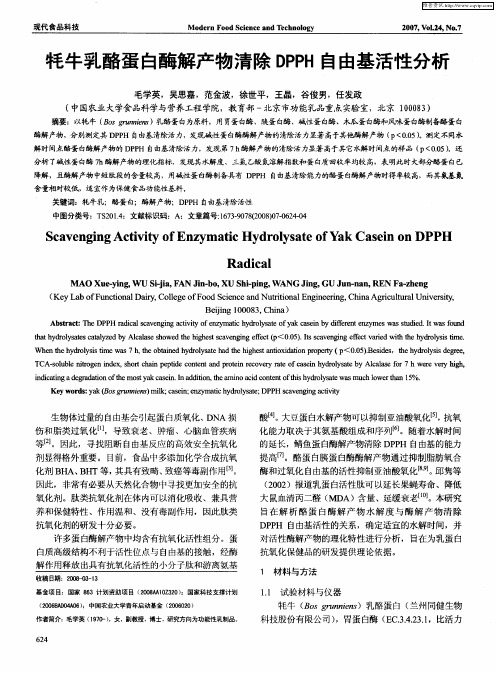
关键词:牦牛乳;酪蛋白;酶解产物;DP H 自由基清除活性 P
中图分类号:T 2 1 ;文献标识码:A;文章篇号: 7.0 820 )702 .4 S0. 4 1 39 7(0 80.6 40 6
S a e g n t i f z m a cHy r l s t f a s i nDPP c v n i gAc i t o y v y En i t d oy a eo k Ca en 0 Y H
Whnte yrl it W , e b ie y rlst hd e i etn o i t n rpr p . ) ei s he yrl idge, e h hdoy s me a 7ht tndh do a a t g s at xd i p e y( <0 5. s e,t hdo s er s i s h oa y e h hh i ao o t 0 B d ys e
n i ti i dc n gad g a a o f emo t a a e . na d t n t ea n cdc n e t f hs y r l s t Wa mu hlwe ta 5 . e rd t no t i h s y kc s i I d i o , n i h mi oa i o t o t i h d oy a n e s c o rh n 1%
Ra i a dc l
MA X e igW Us-a F N Jnb , U h-ig WA GJn , nn n I az e g O u - n , ii, A i-o X S i n , N ig GUJ -a , N F -h n y j p u
( yLa f u cin l i , l g f o d S in ea dNu r in l n i e r g Ch n Ag iu tr l i est, Ke bo F n t a r Co l eo F o ce c n t t a g n e n , i a rc l a v ri o Da y e io E i u Un y
酶解酪蛋白生产生物活性肽的研究现状及开发前景
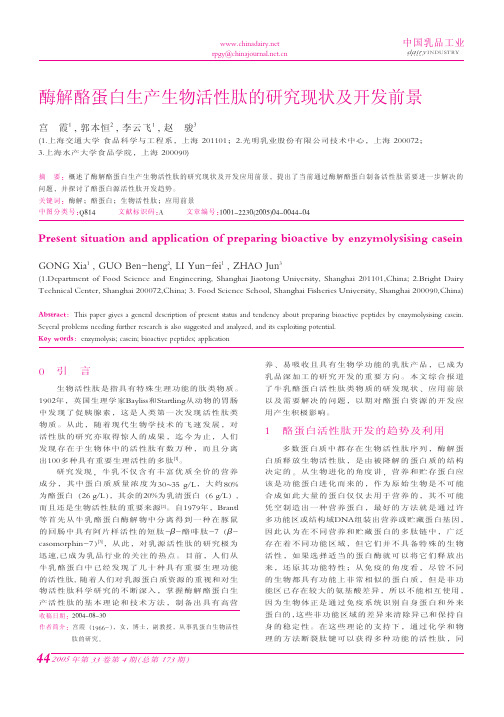
&9&
抗高血压肽 DEB=;AF351=5B?;G5 353=;<5H 血管紧张素转化酶 &E)I ’ 是一种多功能 的 酶 !
$
&!’ 基 因 工 程 方 法 $ 采 用 基 因 工 程 技 术 7 让 某 些 功能明确的活性肽在工程细菌或工程动植物中得到 高效表达 7 从 而 达 到 商 业 化 生 产 的 目 的 $ 人 们 在 这 方 面的工作还是初步的! 在转基因鼠的乳汁中得到了 牛 乳 !! 酪 蛋 白 的 表 达 产 物 ! 并 且 进 行 了 纯 化 ! 牛 乳 的"! 乳白蛋白也在转基因鼠的乳汁中得到表达 $8%$ 通 过基因工程的方法生产分子量较大的肽和蛋白质已 被广泛应用! 而许多生物活性肽都是短肽! 所以也 限制了这种方法的使用 $ & "’ 化 学 合 成 方 法 $ 化 学 合 成 法 用 于 生 产 高 价 的药理级肽! 但是此法的成本相当高! 而且副产物 会对人体有害 ! 因此使用受到限制 $ 总之! 目前生物活性肽的研究开发主要采用微 生物蛋白酶的方法! 国内外在植物蛋白和动物蛋白 的开发研究中利用的微生物蛋白酶已建立的良好的 实验依据! 发现微生物蛋白酶大多具有溶解性好(
56.76,89:; )*+,- 水解酪蛋白得到的酪蛋白水解产物中
都分离到了 !#) 酪 蛋 白 & ./0(*12(312 ’ 和 ! ! 酪 蛋 白 &405(*12(*12 ’ 具有降血压作用的肽段 ! 但是此法存 在对菌种依赖性较大! 如果没有优良的发酵菌种! 那么降低生产成本而实现工业化生产必然存在许多 困难* 另外还存在菌种的安全评价和相关产物分析 等问题
$
& ’’ 微 生 物 发 酵 法 $ 此 法 生 产 多 肽 是 近 年 来 逐 步发展起来的很前景的技术! 直接利用微生物发酵 过 程 中 产 生 的 蛋 白 酶 &复 合 ’ 降 解 蛋 白 质 ! 可 达 到 较高的水解度! 从而相对地降低酶法生产活性肽的 成 本 ! 例 如 ! 在 接 种 了 23456.76,89:; 的 牛 乳 和 用 234
酪蛋白肽的功能主治
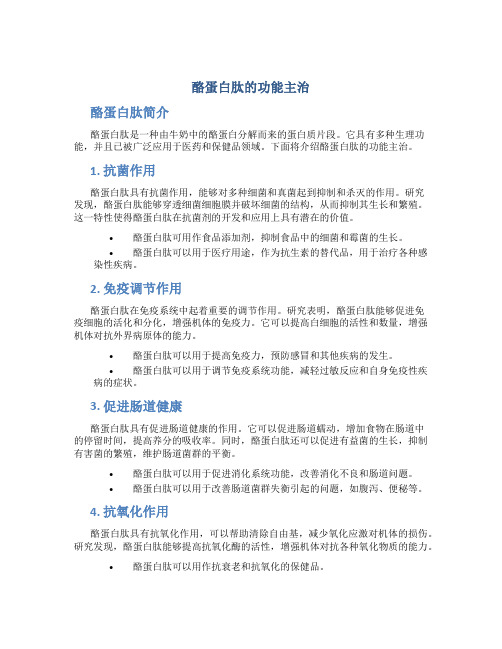
酪蛋白肽的功能主治酪蛋白肽简介酪蛋白肽是一种由牛奶中的酪蛋白分解而来的蛋白质片段。
它具有多种生理功能,并且已被广泛应用于医药和保健品领域。
下面将介绍酪蛋白肽的功能主治。
1. 抗菌作用酪蛋白肽具有抗菌作用,能够对多种细菌和真菌起到抑制和杀灭的作用。
研究发现,酪蛋白肽能够穿透细菌细胞膜并破坏细菌的结构,从而抑制其生长和繁殖。
这一特性使得酪蛋白肽在抗菌剂的开发和应用上具有潜在的价值。
•酪蛋白肽可用作食品添加剂,抑制食品中的细菌和霉菌的生长。
•酪蛋白肽可以用于医疗用途,作为抗生素的替代品,用于治疗各种感染性疾病。
2. 免疫调节作用酪蛋白肽在免疫系统中起着重要的调节作用。
研究表明,酪蛋白肽能够促进免疫细胞的活化和分化,增强机体的免疫力。
它可以提高白细胞的活性和数量,增强机体对抗外界病原体的能力。
•酪蛋白肽可以用于提高免疫力,预防感冒和其他疾病的发生。
•酪蛋白肽可以用于调节免疫系统功能,减轻过敏反应和自身免疫性疾病的症状。
3. 促进肠道健康酪蛋白肽具有促进肠道健康的作用。
它可以促进肠道蠕动,增加食物在肠道中的停留时间,提高养分的吸收率。
同时,酪蛋白肽还可以促进有益菌的生长,抑制有害菌的繁殖,维护肠道菌群的平衡。
•酪蛋白肽可以用于促进消化系统功能,改善消化不良和肠道问题。
•酪蛋白肽可以用于改善肠道菌群失衡引起的问题,如腹泻、便秘等。
4. 抗氧化作用酪蛋白肽具有抗氧化作用,可以帮助清除自由基,减少氧化应激对机体的损伤。
研究发现,酪蛋白肽能够提高抗氧化酶的活性,增强机体对抗各种氧化物质的能力。
•酪蛋白肽可以用作抗衰老和抗氧化的保健品。
•酪蛋白肽可以用于预防和治疗与氧化应激相关的疾病,如心血管疾病、癌症等。
5. 其他功能除了以上功能,酪蛋白肽还具有其他一些功能,如抗炎作用、镇定作用等。
它可以用于治疗炎症性疾病、焦虑和失眠等问题。
•酪蛋白肽可以用于改善炎症性肠病、关节炎等疾病。
•酪蛋白肽可以用于改善焦虑和失眠问题,提高睡眠质量。
酪蛋白磷酸肽的提取流程

酪蛋白磷酸肽的提取流程下载温馨提示:该文档是我店铺精心编制而成,希望大家下载以后,能够帮助大家解决实际的问题。
文档下载后可定制随意修改,请根据实际需要进行相应的调整和使用,谢谢!并且,本店铺为大家提供各种各样类型的实用资料,如教育随笔、日记赏析、句子摘抄、古诗大全、经典美文、话题作文、工作总结、词语解析、文案摘录、其他资料等等,如想了解不同资料格式和写法,敬请关注!Download tips: This document is carefully compiled by the editor. I hope that after you download them, they can help yousolve practical problems. The document can be customized and modified after downloading, please adjust and use it according to actual needs, thank you!In addition, our shop provides you with various types of practical materials, such as educational essays, diary appreciation, sentence excerpts, ancient poems, classic articles, topic composition, work summary, word parsing, copy excerpts,other materials and so on, want to know different data formats and writing methods, please pay attention!酪蛋白磷酸肽是一种具有重要生物学功能的天然产物,具有抗氧化、抗菌、抗病毒等多种生理活性。
DPPH和ABTS、PTIO自由基清除实验-疑难解答-李熙灿-Xican-Li
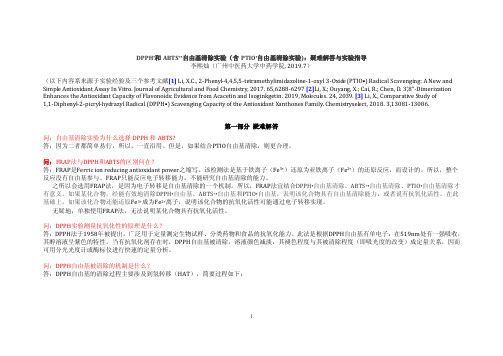
DPPH•和ABTS+•自由基清除实验(含PTIO•自由基清除实验):疑难解答与实验指导李熙灿(广州中医药大学中药学院, 2019.7)(以下内容系来源于实验经验及三个参考文献[1] Li, X.C., 2-Phenyl-4,4,5,5-tetramethylimidazoline-1-oxyl 3-Oxid e (PTIO•) Radical Scavenging: A New and Simpl e Antioxidant Assay In Vitro. Journal of Agricultural and Food Chemistry, 2017. 65,6288-6297 [2]Li, X.; Ouyang, X.; Cai, R.; Chen, D. 3’,8”-Dimerization Enhances the Antioxidant Capacity of Flavonoids: Evid ence from Acacetin and Isoginkgetin. 2019, Mol ecul es. 24, 2039. [3] Li, X., Comparative Study of1,1-Diphenyl-2-picryl-hyd razyl Radical (DPPH•) Scavenging Capacity of the Antioxidant Xanthones Family. Chemistrysel ect, 2018. 3,13081-13086.第一部分疑难解答问:自由基清除实验为什么选择DPPH和ABTS?答:因为二者都简单易行,所以,一直沿用。
但是,如果结合PTIO自由基清除,则更合理。
问:FRAP法与DPPH和ABTS的区别何在?答:FRAP是Ferric ion reducing antioxidant power之缩写。
该检测法是基于铁离子(Fe3+)还原为亚铁离子(Fe2+)的还原反应,而设计的。
功能食品生产实验报告(3篇)

第1篇一、实验目的本实验旨在了解和掌握功能食品的基本生产流程,通过实际操作,学习生物工程技术、分离纯化技术、超微粉碎技术、冷冻干燥技术、微胶囊技术、冷杀菌技术等在功能食品生产中的应用,并探究活性多糖、活性多肽、功能性油脂、自由基清除剂、活性菌类及功能性甜味料等生物活性物质的提取和加工技术。
二、实验材料与设备材料:1. 活性多糖:膳食纤维、真菌活性多糖、植物活性多糖2. 活性多肽:酪蛋白磷酸肽、谷胱甘肽、降血压肽3. 功能性油脂4. 自由基清除剂:超氧化物歧化酶5. 活性菌类6. 功能性甜味料设备:1. 生物反应器2. 超微粉碎机3. 冷冻干燥机4. 微胶囊制备设备5. 冷杀菌设备6. 分离纯化设备(如离心机、滤膜等)7. 分析仪器(如高效液相色谱仪、紫外分光光度计等)三、实验方法1. 活性多糖提取与加工:- 采用热水提取法提取膳食纤维、真菌活性多糖和植物活性多糖。
- 对提取液进行浓缩、干燥,得到活性多糖粉末。
2. 活性多肽提取与加工:- 利用酶解-沉淀法提取酪蛋白磷酸肽。
- 采用萃取法提取谷胱甘肽。
- 通过酶解-离子交换法提取降血压肽。
3. 功能性油脂提取与加工:- 采用压榨法提取植物油中的功能性油脂。
- 对提取液进行精炼,得到纯净的功能性油脂。
4. 自由基清除剂提取与加工:- 采用沉淀法制备超氧化物歧化酶。
- 利用离子交换层析法纯化超氧化物歧化酶。
5. 活性菌类提取与加工:- 从土壤或食品中筛选活性菌类。
- 对筛选出的活性菌类进行培养、发酵,得到活性菌类产品。
6. 功能性甜味料提取与加工:- 采用水提法提取天然甜味剂。
- 对提取液进行浓缩、干燥,得到功能性甜味料粉末。
四、实验结果与分析1. 活性多糖提取与加工:- 膳食纤维、真菌活性多糖和植物活性多糖的提取率分别为85%、90%和88%。
- 活性多糖粉末的纯度分别为95%、92%和96%。
2. 活性多肽提取与加工:- 酪蛋白磷酸肽、谷胱甘肽和降血压肽的提取率分别为70%、80%和75%。
制备、纯化和鉴定生物活性肽的研究进展及应用

制备、纯化和鉴定生物活性肽的研究进展及应用刘铭;刘玉环;王允圃;阮榕生;樊亮亮;邹慧芳;涂春明【摘要】近年来,分离纯化以及鉴定技术的发展加速了生物活性肽的研究进程.生物活性肽被定义为具有生物活性,诸如抗氧化、降血压、抗血栓、减脂、抑菌和抗炎症功效等的,由2~20个氨基酸组成的特定肽类的总称.低毒和高特异性的特点使生物活性肽在食品和医药行业有着独特应用价值.文中重点综述了生物活性肽的制备,特别是微生物发酵和酶水解,并分析了各种技术手段的联用和辅助手段的运用.为了确定表征生物活性肽的主要方法,对分离、纯化和鉴定的方法进行了总结.最后,还对商业化应用中面临的挑战进行了分析.【期刊名称】《食品与发酵工业》【年(卷),期】2016(042)004【总页数】8页(P244-251)【关键词】生物活性肽;纯化;鉴定;应用挑战【作者】刘铭;刘玉环;王允圃;阮榕生;樊亮亮;邹慧芳;涂春明【作者单位】南昌大学食品科学与技术国家重点实验室,江西南昌,330047;南昌大学生物质教育部工程研究中心,江西南昌,330047;南昌大学食品科学与技术国家重点实验室,江西南昌,330047;南昌大学生物质教育部工程研究中心,江西南昌,330047;南昌大学食品科学与技术国家重点实验室,江西南昌,330047;南昌大学生物质教育部工程研究中心,江西南昌,330047;明尼苏达大学生物制品与生态工程系,美国明尼苏达,55108;南昌大学食品科学与技术国家重点实验室,江西南昌,330047;南昌大学生物质教育部工程研究中心,江西南昌,330047;南昌大学食品科学与技术国家重点实验室,江西南昌,330047;南昌大学生物质教育部工程研究中心,江西南昌,330047;南昌大学食品科学与技术国家重点实验室,江西南昌,330047;南昌大学生物质教育部工程研究中心,江西南昌,330047【正文语种】中文蛋白质是人体必需的营养成分之一,是对于人体生长和维持正常生理代谢必不可少的必需氨基酸的来源,同时也是机体能量的来源。
国家项目胶束酪蛋白提取分离关键技术及加工制备
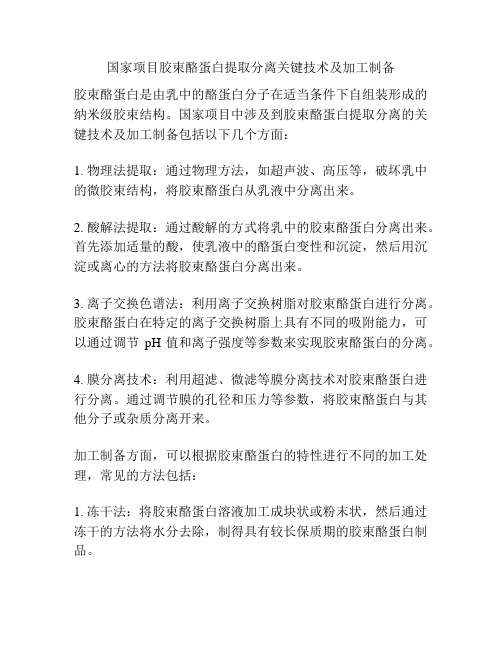
国家项目胶束酪蛋白提取分离关键技术及加工制备
胶束酪蛋白是由乳中的酪蛋白分子在适当条件下自组装形成的纳米级胶束结构。
国家项目中涉及到胶束酪蛋白提取分离的关键技术及加工制备包括以下几个方面:
1. 物理法提取:通过物理方法,如超声波、高压等,破坏乳中的微胶束结构,将胶束酪蛋白从乳液中分离出来。
2. 酸解法提取:通过酸解的方式将乳中的胶束酪蛋白分离出来。
首先添加适量的酸,使乳液中的酪蛋白变性和沉淀,然后用沉淀或离心的方法将胶束酪蛋白分离出来。
3. 离子交换色谱法:利用离子交换树脂对胶束酪蛋白进行分离。
胶束酪蛋白在特定的离子交换树脂上具有不同的吸附能力,可以通过调节pH值和离子强度等参数来实现胶束酪蛋白的分离。
4. 膜分离技术:利用超滤、微滤等膜分离技术对胶束酪蛋白进行分离。
通过调节膜的孔径和压力等参数,将胶束酪蛋白与其他分子或杂质分离开来。
加工制备方面,可以根据胶束酪蛋白的特性进行不同的加工处理,常见的方法包括:
1. 冻干法:将胶束酪蛋白溶液加工成块状或粉末状,然后通过冻干的方法将水分去除,制得具有较长保质期的胶束酪蛋白制品。
2. 乳化法:将胶束酪蛋白与其他成分(如油脂、糖等)进行乳化混合,制成胶体状的乳化制品,如酪蛋白奶霜、奶油等。
3. 热处理法:通过加热胶束酪蛋白溶液,使其蛋白质发生变性并聚集,形成块状或胶态的固体制品,如酪蛋白酸奶、酪蛋白酵素等。
以上是国家项目中涉及的胶束酪蛋白提取分离关键技术及加工制备的一些方面,具体的方法和过程可能会有所不同,需要根据具体项目的需求进行调整和优化。
酪蛋白水解肽的作用
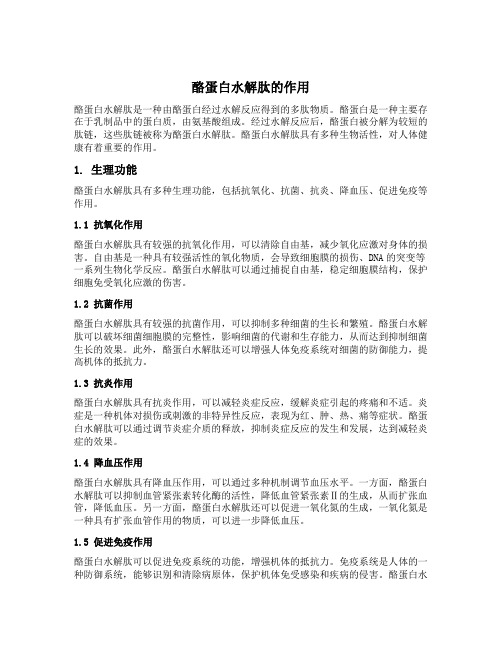
酪蛋白水解肽的作用酪蛋白水解肽是一种由酪蛋白经过水解反应得到的多肽物质。
酪蛋白是一种主要存在于乳制品中的蛋白质,由氨基酸组成。
经过水解反应后,酪蛋白被分解为较短的肽链,这些肽链被称为酪蛋白水解肽。
酪蛋白水解肽具有多种生物活性,对人体健康有着重要的作用。
1. 生理功能酪蛋白水解肽具有多种生理功能,包括抗氧化、抗菌、抗炎、降血压、促进免疫等作用。
1.1 抗氧化作用酪蛋白水解肽具有较强的抗氧化作用,可以清除自由基,减少氧化应激对身体的损害。
自由基是一种具有较强活性的氧化物质,会导致细胞膜的损伤、DNA的突变等一系列生物化学反应。
酪蛋白水解肽可以通过捕捉自由基,稳定细胞膜结构,保护细胞免受氧化应激的伤害。
1.2 抗菌作用酪蛋白水解肽具有较强的抗菌作用,可以抑制多种细菌的生长和繁殖。
酪蛋白水解肽可以破坏细菌细胞膜的完整性,影响细菌的代谢和生存能力,从而达到抑制细菌生长的效果。
此外,酪蛋白水解肽还可以增强人体免疫系统对细菌的防御能力,提高机体的抵抗力。
1.3 抗炎作用酪蛋白水解肽具有抗炎作用,可以减轻炎症反应,缓解炎症引起的疼痛和不适。
炎症是一种机体对损伤或刺激的非特异性反应,表现为红、肿、热、痛等症状。
酪蛋白水解肽可以通过调节炎症介质的释放,抑制炎症反应的发生和发展,达到减轻炎症的效果。
1.4 降血压作用酪蛋白水解肽具有降血压作用,可以通过多种机制调节血压水平。
一方面,酪蛋白水解肽可以抑制血管紧张素转化酶的活性,降低血管紧张素Ⅱ的生成,从而扩张血管,降低血压。
另一方面,酪蛋白水解肽还可以促进一氧化氮的生成,一氧化氮是一种具有扩张血管作用的物质,可以进一步降低血压。
1.5 促进免疫作用酪蛋白水解肽可以促进免疫系统的功能,增强机体的抵抗力。
免疫系统是人体的一种防御系统,能够识别和清除病原体,保护机体免受感染和疾病的侵害。
酪蛋白水解肽可以增强机体的免疫细胞活性,促进免疫细胞的增殖和分化,提高机体对病原体的识别和清除能力。
酪蛋白肽的作用及功能主治
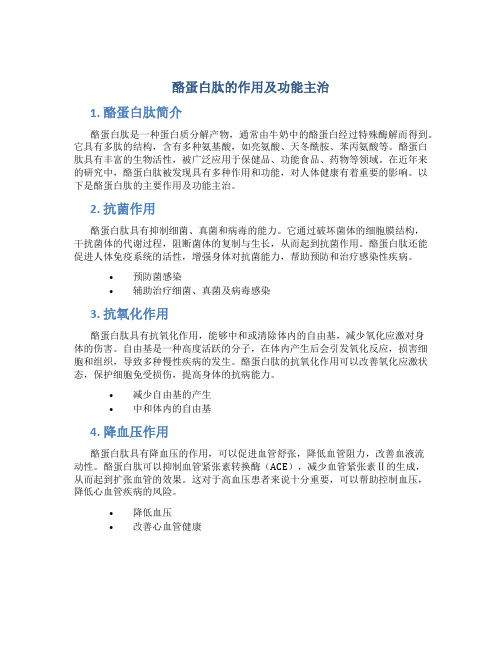
酪蛋白肽的作用及功能主治1. 酪蛋白肽简介酪蛋白肽是一种蛋白质分解产物,通常由牛奶中的酪蛋白经过特殊酶解而得到。
它具有多肽的结构,含有多种氨基酸,如亮氨酸、天冬酰胺、苯丙氨酸等。
酪蛋白肽具有丰富的生物活性,被广泛应用于保健品、功能食品、药物等领域。
在近年来的研究中,酪蛋白肽被发现具有多种作用和功能,对人体健康有着重要的影响。
以下是酪蛋白肽的主要作用及功能主治。
2. 抗菌作用酪蛋白肽具有抑制细菌、真菌和病毒的能力。
它通过破坏菌体的细胞膜结构,干扰菌体的代谢过程,阻断菌体的复制与生长,从而起到抗菌作用。
酪蛋白肽还能促进人体免疫系统的活性,增强身体对抗菌能力,帮助预防和治疗感染性疾病。
•预防菌感染•辅助治疗细菌、真菌及病毒感染3. 抗氧化作用酪蛋白肽具有抗氧化作用,能够中和或清除体内的自由基,减少氧化应激对身体的伤害。
自由基是一种高度活跃的分子,在体内产生后会引发氧化反应,损害细胞和组织,导致多种慢性疾病的发生。
酪蛋白肽的抗氧化作用可以改善氧化应激状态,保护细胞免受损伤,提高身体的抗病能力。
•减少自由基的产生•中和体内的自由基4. 降血压作用酪蛋白肽具有降血压的作用,可以促进血管舒张,降低血管阻力,改善血液流动性。
酪蛋白肽可以抑制血管紧张素转换酶(ACE),减少血管紧张素Ⅱ的生成,从而起到扩张血管的效果。
这对于高血压患者来说十分重要,可以帮助控制血压,降低心血管疾病的风险。
•降低血压•改善心血管健康5. 抗炎作用炎症是人体自身对外界刺激做出的一种病理反应,会导致组织损伤和疾病的发生。
酪蛋白肽具有抗炎作用,可以抑制炎症介质的释放,减轻炎症反应,促进组织修复和愈合。
酪蛋白肽还可以调节免疫系统的功能,增强机体的抗炎能力,对于预防和治疗炎症性疾病具有一定的疗效。
•减轻炎症反应•促进组织修复和愈合6. 增强免疫力酪蛋白肽对免疫系统具有调节作用,可以增强机体的免疫力。
免疫系统是人体抵御外界病原体入侵的重要防线,酪蛋白肽可以促进免疫细胞的活性和增殖,增加抗体的产生,提高机体的抗病能力。
牛乳源生物活性肽研究与应用进展
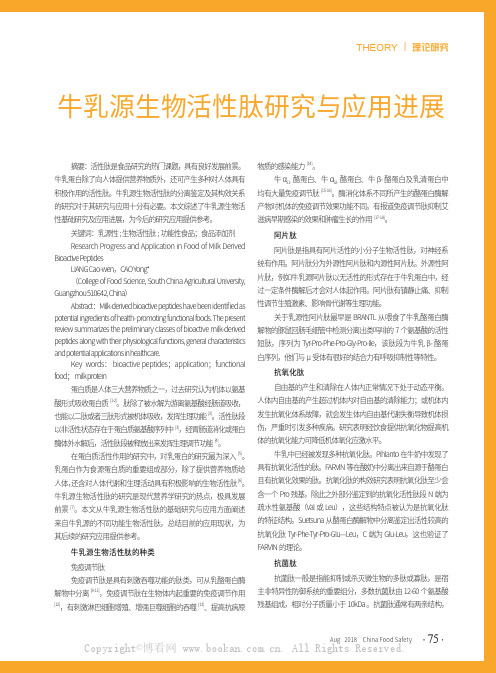
THEORY | 理论研究Aug. 2018 China Food Safety »·75·牛乳源生物活性肽研究与应用进展摘要:活性肽是食品研究的热门课题,具有良好发展前景。
牛乳蛋白除了向人体提供营养物质外,还可产生多种对人体具有积极作用的活性肽。
牛乳源生物活性肽的分离鉴定及其构效关系的研究对于其研究与应用十分有必要。
本文综述了牛乳源生物活性基础研究及应用进展,为今后的研究应用提供参考。
关键词:乳源性; 生物活性肽;功能性食品;食品添加剂 Research Progress and Application in Food of Milk Derived Bioactive P eptidesLIANG Cao-wen,CAO Y ong *(College of Food Science, South China Agricultural University, Guangzhou 510642, China)Abs tr act:Milk -derived bioactive peptides have been identified as potential ingredients of health- promoting functional foods. The present review summarizes the preliminary classes of bioactive milk-derived peptides along with their physiological functions, gener al char acteris ticsand potential applications in healthcare.Key words: bioactive peptides;application;functional food; milk protein蛋白质是人体三大营养物质之一,过去研究认为机体以氨基酸形式吸收蛋白质[1-2]。
活性肽简介
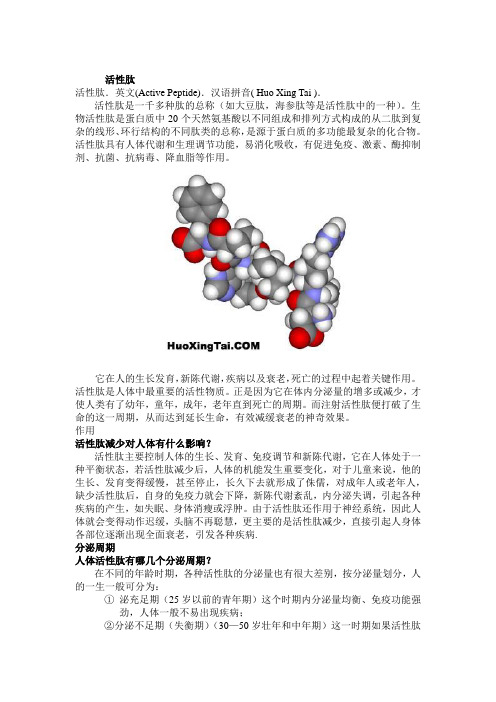
活性肽活性肽.英文(Active Peptide).汉语拼音( Huo Xing Tai ).活性肽是一千多种肽的总称(如大豆肽,海参肽等是活性肽中的一种)。
生物活性肽是蛋白质中20个天然氨基酸以不同组成和排列方式构成的从二肽到复杂的线形、环行结构的不同肽类的总称,是源于蛋白质的多功能最复杂的化合物。
活性肽具有人体代谢和生理调节功能,易消化吸收,有促进免疫、激素、酶抑制剂、抗菌、抗病毒、降血脂等作用。
它在人的生长发育,新陈代谢,疾病以及衰老,死亡的过程中起着关键作用。
活性肽是人体中最重要的活性物质。
正是因为它在体内分泌量的增多或减少,才使人类有了幼年,童年,成年,老年直到死亡的周期。
而注射活性肽便打破了生命的这一周期,从而达到延长生命,有效减缓衰老的神奇效果。
作用活性肽减少对人体有什么影响?活性肽主要控制人体的生长、发育、免疫调节和新陈代谢,它在人体处于一种平衡状态,若活性肽减少后,人体的机能发生重要变化,对于儿童来说,他的生长、发育变得缓慢,甚至停止,长久下去就形成了侏儒,对成年人或老年人,缺少活性肽后,自身的免疫力就会下降,新陈代谢紊乱,内分泌失调,引起各种疾病的产生,如失眠、身体消瘦或浮肿。
由于活性肽还作用于神经系统,因此人体就会变得动作迟缓,头脑不再聪慧,更主要的是活性肽减少,直接引起人身体各部位逐渐出现全面衰老,引发各种疾病.分泌周期人体活性肽有哪几个分泌周期?在不同的年龄时期,各种活性肽的分泌量也有很大差别,按分泌量划分,人的一生一般可分为:①泌充足期(25岁以前的青年期)这个时期内分泌量均衡、免疫功能强劲,人体一般不易出现疾病;②分泌不足期(失衡期)(30—50岁壮年和中年期)这一时期如果活性肽分泌不足或失衡会出现各种相关的亚健康状态和轻微疾病症状(40岁以上的人群常见);③分泌匮乏期(严重不足期)(50岁以上中年和老年期)这一时期严重如果活性肽严重不足和严重失衡,可能出现非常突出的衰老症状,或会引起各种相关疾病发生(50岁以上人群比较明显);④分泌终止期(衰老期),这一时期很短,由于控制人体内分泌的“司令官”活性肽不分泌或分泌减少,从而导致细胞功能衰退,引发器官功能衰竭和丧失,最后导致生命终结。
水解酪蛋白肽作用

水解酪蛋白肽作用水解酪蛋白肽是一种具有丰富营养和生理活性的蛋白质分解产物。
它是由酪蛋白经过水解反应得到的,具有较小的分子量和良好的生物利用度。
在人体内,水解酪蛋白肽具有多种生理功能,包括促进消化吸收、增强免疫力、调节血压和抗氧化等。
水解酪蛋白肽的主要成分是含有丰富氨基酸的多肽。
这些氨基酸包括谷氨酸、异亮氨酸、苯丙氨酸等,它们是构成蛋白质的基本单位。
由于水解酪蛋白肽的分子量较小,因此它们能够更容易被人体吸收和利用。
这使得水解酪蛋白肽成为一种理想的蛋白质来源,尤其适合那些消化系统功能不完善的人群,如婴儿、老年人和病患者。
在消化系统中,水解酪蛋白肽能够被胃酸和胃蛋白酶迅速分解成小肽和游离氨基酸。
这些小肽和氨基酸能够被肠道上皮细胞主动地吸收进入血液循环系统,进而供给全身各组织和器官使用。
相比之下,未经水解的酪蛋白由于分子量大,往往不能被充分吸收,造成浪费。
水解酪蛋白肽还具有增强免疫力的作用。
研究表明,酪蛋白中的一些肽段能够通过与免疫细胞表面的受体结合,激活免疫细胞,增强机体的抵抗力。
此外,水解酪蛋白肽还能够促进某些免疫因子的产生,提高机体对病原微生物的识别和清除能力。
水解酪蛋白肽还被证明具有调节血压的作用。
酪蛋白中的某些肽段能够抑制血管紧张素转化酶的活性,从而降低血管紧张素Ⅱ的生成,进而减轻血管收缩,降低血压。
此外,水解酪蛋白肽还能够促进一氧化氮的释放,扩张血管,进一步降低血压。
水解酪蛋白肽还具有抗氧化作用。
酪蛋白中的一些肽段能够中和体内自由基,减轻氧化应激对细胞和组织的损伤。
此外,水解酪蛋白肽还能够促进抗氧化酶的活性,增强体内的抗氧化能力。
这些作用有助于预防和延缓多种疾病的发生,如心血管疾病、癌症和老年痴呆等。
水解酪蛋白肽作为一种具有丰富营养和生理活性的蛋白质分解产物,在人体内发挥着重要的作用。
它能够促进消化吸收、增强免疫力、调节血压和抗氧化等。
因此,适当摄入水解酪蛋白肽有助于维持人体健康。
当然,在使用水解酪蛋白肽时,我们也应该注意适量摄入,避免过量造成不良反应。
酪蛋白组分分离、纯化研究的开题报告
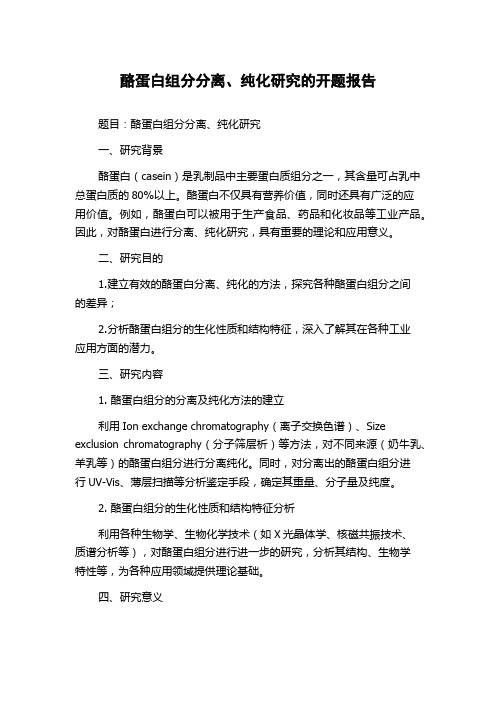
酪蛋白组分分离、纯化研究的开题报告题目:酪蛋白组分分离、纯化研究一、研究背景酪蛋白(casein)是乳制品中主要蛋白质组分之一,其含量可占乳中总蛋白质的80%以上。
酪蛋白不仅具有营养价值,同时还具有广泛的应用价值。
例如,酪蛋白可以被用于生产食品、药品和化妆品等工业产品。
因此,对酪蛋白进行分离、纯化研究,具有重要的理论和应用意义。
二、研究目的1.建立有效的酪蛋白分离、纯化的方法,探究各种酪蛋白组分之间的差异;2.分析酪蛋白组分的生化性质和结构特征,深入了解其在各种工业应用方面的潜力。
三、研究内容1. 酪蛋白组分的分离及纯化方法的建立利用Ion exchange chromatography(离子交换色谱)、Size exclusion chromatography(分子筛层析)等方法,对不同来源(奶牛乳、羊乳等)的酪蛋白组分进行分离纯化。
同时,对分离出的酪蛋白组分进行UV-Vis、薄层扫描等分析鉴定手段,确定其重量、分子量及纯度。
2. 酪蛋白组分的生化性质和结构特征分析利用各种生物学、生物化学技术(如X光晶体学、核磁共振技术、质谱分析等),对酪蛋白组分进行进一步的研究,分析其结构、生物学特性等,为各种应用领域提供理论基础。
四、研究意义1. 建立有效的酪蛋白分离、纯化方法,为酪蛋白的应用提供良好的基础和保障;2. 深入了解酪蛋白组分的生化性质和结构特征,为其在各个工业领域的应用提供指导意见。
五、研究计划1. 第一阶段——实验前期准备(1个月)1)收集有关国内外酪蛋白组分研究的文献资料,了解常见的分离、纯化方法及其优缺点;2)筛选分离酪蛋白组分的最佳实验方案2. 第二阶段——试验设计及样品分离、纯化(2个月)按照前期的试验方案,采用离子交换色谱、分子筛层析等方法,对样品(奶牛乳、羊乳等)进行酪蛋白组分的分离和纯化。
同时,对纯化后的组分进行质量鉴定,以确定其完整性和纯度水平。
3. 第三阶段——组分结构和应用评价(2个月)对分离纯化后的酪蛋白组分进行结构及性质分析,进一步研究其在各个领域的应用。
- 1、下载文档前请自行甄别文档内容的完整性,平台不提供额外的编辑、内容补充、找答案等附加服务。
- 2、"仅部分预览"的文档,不可在线预览部分如存在完整性等问题,可反馈申请退款(可完整预览的文档不适用该条件!)。
- 3、如文档侵犯您的权益,请联系客服反馈,我们会尽快为您处理(人工客服工作时间:9:00-18:30)。
Isolation and characterization of free radical scavenging activities peptides derived from caseinKunio Suetsuna,*Hiroyuki Ukeda,†and Hirotomo Ochi ‡*Department of Food Science and Technology,National Fisheries University,Shimonoseki,Japan;†Department of Bioresources Science,Faculty of Agriculture,Kochi University,Kochi,Japan;and ‡Japan Institute for the Control of Aging,Shizuoka,JapanA peptide having the strong free radical scavenging activities was separated from casein protein hydrolysate by chromatographic analyses such as ion-exchange and gel filtration.SP-II fraction obtained by SP-Sephadex C-25chromatography showed the most potent superoxide anion scavenging activity (SOSA),and it was further separated into a peptide using an octadecylsilano-high performance liquid chromatography.The amino acid sequence of the peptide was Tyr-Phe-Tyr-Pro-Glu-Leu (YFYPEL).The concentration of the test compound required to reduce the produced superoxide anion to one-half (IC 50)value for SOSA was 79.2M using tetrazolium salt 3Ј-{1-[(phenylamino)-carbonyl]-3,4-tetrazolium}-bis(4-methoxy-6-nitro)benzenesulfonic acid hydrate method.The IC 50value for the 1,1-diphenyl-2-picrylhydrazyl radical and hydroxyl radical scavenging activities were 98and 251M,respectively,based on the electron spin resonance method.We characterized SOSA of the C-terminal sequence using EL,PEL,YPEL,and FYPEL.The activities of preferred sequences were EL ϾYFYPEL ϾFYPEL ϾYPEL ϾPEL,suggesting that the Glu-Leu sequence is important for the activity.(J.Nutr.Biochem.11:128–131,2000)©Elsevier Science Inc.2000.All rights reserved.Keywords :peptide from casein;free radical scavenging activity;superoxide anion radical;DPPH radical;hydroxyl radical;tetrazolium salt XTT;ESRIntroductionFree radicals and active oxygen species such as the oxygen molecule behave as double-edged swords.They are impor-tant mediators in signal transduction and play a vital role in the production of biologically active and essential com-pounds.At the same time,however,they are toxic and known to play a causative role in a variety of diseases including cancer and aging.They attack lipids,proteins,and DNA to induce peroxidation,modification,and strand break.1Aerobic organisms are protected from such oxidative stress by various defense systems.The capacity of such protective systems,however,gradually decreases with ag-ing,resulting in disturbances to the normal redox equilib-rium established in healthy systems.Therefore,to replenish this aging-induced loss,the body must be provided with a constant supply of phytochemicals by the regular intake of a proper diet.2Some proteins from certain foods were found to have the scavenging activity of active oxygen species.3Although the mechanism remains to be elucidated,the primary sequence may contribute to generate the activity.As an example,milk casein was reported to inhibit lipoxygenase-catalyzed lipid autoxidation.4Quenching of free radicals by oxidation of amino acid residues in casein was proposed as the explana-tion.However,free amino acids could not substitute for casein as the antioxidant,suggesting that the primary structure of casein molecules played a role.4To clarify whether a primary sequence in milk casein has the radical scavenging activity,we isolated,purified,and identified free radical scavenging activity peptide derived from the peptic digest of casein.Further comparative studies for free radical scavenging activity of synthetic fragment peptides have been performed.Address correspondence to Dr.K.Suetsuna at the Department of Food Science and Technology,National Fisheries University,2-7-1Nagata-Honmachi,Shimonoseki,Yamaguchi 759-6595,Japan.Received October 14,1999;accepted November 15,1999.J.Nutr.Biochem.11:128–131,2000©Elsevier Science Inc.2000.All rights reserved.0955-2863/00/$–see front matter655Avenue of the Americas,New York,NY 10010PII S0955-2863(99)00083-2Materials and methodsMaterialsMilk casein was purchased from Oriental Yeast Co.(Tokyo, Japan).Pepsin(from porcine gastric mucosa,EC3.4.23.1)from Merck Co.(Darmstadt,Germany)and superoxide dismutase (SOD;from bovine erythrocytes,EC 1.15.1.1;3380units/mg protein),xanthine oxidase(XOD;from buttermilk,EC1.2.3.2;0.3 units/mg),3Ј-{1-[(phenylamino)-carbonyl]-3,4-tetrazolium}-bis(4-methoxy-6-nitro)benzenesulfonic acid hydrate(XTT),and5,5-diethyl-1-pyrroline-N-oxide(DMPO)from Sigma Chemical Co. (St.Louis,MO USA)were used as received.All other reagents were of analytical grade from Nacalai Tesque Co.(Tokyo,Japan) or Wako Pure Chemical Industries(Osaka,Japan). Purification of the peptide from milk caseinThirty grams of milk casein were homogenized in100mL of deionized water.The pH value of the homogenate was adjusted to 2.0with2N HCl,and0.9g of pepsin was added.After20hours of digestion at37°C,the hydrolysate was filtered to remove the residue and centrifuged at20,000ϫg for20minutes at4°C.The supernatant(100mL)was applied to a Dowex50W column(2.6ϫ20cm,50–100mesh,Hϩform;Muromachi Kagaku,Tokyo, Japan).The column was washed thoroughly with deionized water, and the retained peptides were then eluted with300mL of2NNH4OH.The peptide fraction was concentrated to5mL undervacuum.The concentrate was applied to a Sephadex G-25column (2.6ϫ140cm;Pharmacia LKB Biotechnology,Uppsala,Sweden) equilibrated with deionized water and gel-filtrated at a flow rate of 30mL/hr.Each fraction of7.8mL was collected.Protein content of each fraction was measured by the Lowry method,5using bovine serum albumin as the standard.The peptide fractions (molecular weight range300–5,000)were pooled and evaporated to dryness to give a peptide powder.Two grams of the peptide powder were dissolved in deionized water and applied to an SP-Sephadex C-25column(2ϫ50cm,Hϩform;Pharmacia LKB Biotechnology)equilibrated with deionized water.The column was chromatographed using the linear gradient method with1L of deionized water to1L of3%NaCl solution at a flow rate of90 mL/hr,and fractions of8.6mL were collected.The peptide fractions were collected and freeze-dried.Purification of the peptide by reversed-phase high performance liquid chromatography and peptide identification and synthesisThe fraction eluted from SP-Sephadex C-25was collected and assayed for superoxide anion scavenging activity(SOSA).Among those fractions,a solution(7mg/25L)from the fraction with the highest activity was further isolated and purified by reversed-phase high performance liquid chromatography(HPLC)with a column (4.6ϫ250cm)of Develosil ODS-5(Nomura Chemical,Ltd., Nagoya,Japan)using a linear gradient of acetonitrile(MeCN)from0 to16%in0.05%trifluoroacetic acid(TFA)for2hours at a flow rate of1.0mL/min,and the eluent was monitored at220nm.Amino acid analysis of peptide was carried out in6N hydrochloric acid containing0.1%phenol at110°C for24hours using a PICO-TAG™amino acid analyzer(Waters Ltd.,Milford, MA USA).Sequence analysis was done by stepwise Edman degradation using a477A gas-phase automated sequencer(Ap-plied Biosystems,Inc.,Foster City,CA USA)coupled to HPLC, and by identification of the resulting PTH-amino acid compounds.The molecular formula of each peptide was confirmed by fast atom bombardment mass spectrometry(FAB-MS)obtained with a JEOL DX-300spectrometer(JEOL Co.,Tokyo,Japan).Peptides were synthesized by a solid-phase method using a 433A automated peptide synthesizer(Applied Biosystems,Inc.), followed by treatment with hydrogen fluoride to cut off the support resin and to remove all of the protecting groups.The final products were homogeneous on high-resolution reversed-phase HPLC with a Develosil ODS column(4.6ϫ150mm),using gradient of MeCN from0to16.7%in0.05%TFA for2hours at a flow rate of0.8mL/min,and the eluent was monitored at215nm.The result of amino acid analyses and sequence analyses was in agreement with each expected value.Assay of SOSA by tetrazolium salt XTT method6Into2.5mL of50mM sodium carbonate buffer(pH10.2)were added0.1mL each of3mM xanthine,3mM ethylendaimine-tetraacetic acid(EDTA),0.75mM XTT solution,andsample Figure1Column chromatogram of casein peptide on SP-Sephadex C-25.The protein component(E)was determined using the Lowry method,and the bovine serum albumin was used as thestandard.Figure2Scavenging of superoxide anion with peptide fractions from SP-Sephadex C-25chromatography.SP-I,‚;SP-II,E;SP-III,ᮀ.Free radical scavenging activities:Suetsuna et al.J.Nutr.Biochem.,2000,vol.11,March129solution or water.The reaction was initiated by the addition of 56mU/mL XOD solution (0.1mL).The absorbance change at 470nm for 20minutes was monitored with a UVIDEC 220E spectro-photometer (JASCO,Tokyo,Japan)thermostated at 25°C.The concentration of the test compound required to reduce the pro-duced superoxide anion to one-half (IC 50)was calculated.Assay of 1,1-diphenyl-2-picrylhydrazyl radical and hydroxyl radical scavenging activity by electron spin resonance 7The activity of the peptide to scavenge 1,1-diphenyl-2-picrylhy-drazyl (DPPH)radical was examined by the spin trapping method using a JES-FR 30electron spin resonance (ESR)spectrometer (JEOL).One hundred microliters of 150M DPPH in ethanol were put in a test tube and stirred after the addition of 100L of tested compound solution to initiate the reaction.The reaction mixture was then transferred to a quartz cell used for the measurement of ESR.One minute after initiation of the reaction,DPPH radical was measured,and IC 50values (the concentration of the test compounds required to reduce DPPH radical to one-half)were calculated.Conditions for the ESR measurement were as follows:magnetic field,336Ϯ10mT;response time,0.1second;sweeping time,1minute (interval of 10mT).The activity of the peptide to scavenge the hydroxyl radical produced was examined by the spin trapping method using DMPO as the spin trapping agent.Seventy-five microliters of 1mM FeSO 4in 0.1mM sodium phosphate buffer (pH 7.8)containing EDTA,50L of tested compound solution,and 10L of 0.9M DMPO were successively put into a test tube,and stirred after theaddition of 75L of 10mM hydrogen peroxide (H 2O 2)to initiate the reaction.The reaction mixture was then transferred to a quartz cell used for the measurement of ESR.One minute after initiation of the reaction,formed DMPO-OH was measured,and IC 50values (the concentrations of the test compounds required to reduce the produced hydroxyl radical to one-half)were calculated.The conditions for the ESR measurement were as follows:magnetic field,336Ϯ5mT;output,10mW;modulating,100kHz with 0.1mT;response time,0.1second;sweeping time,1minute (interval of 10mT);and amplification ratio,125.ResultsPeptides having strong SOSA were isolated from peptic hydrolysate of casein using a Dowex 50W (H ϩ),Sephadex G-25column as described previously.8The fractions having molecular weights ranging from 300to 5,000were collected and concentrated to dryness to give a peptide powder.The yield of the peptide powder with SOSA from 30g of milk casein was 2.68g.The peptides were fractionated by ion-exchange chromatography on SP-Sephadex C-25(H ϩ)to give SP-I (fraction number 10–33),SP-II (34–51),and SP-III (52–85)as shown in Figure 1.Figure 2shows SOSA of those casein peptide fractions from SP-Sephadex C-25chromatog-raphy.The IC 50values of peptide fractions were SP-I,5.1mg/mL;SP-II,0.06mg/mL;and SP-III,22.9mg/mL.The SP-II fraction (average molecular weight,1,000)showed strongest SOSA using tetrazolium salt XTTmethod.Figure 3A chromatogram on reversed-phase Develosil ODS-5column of the ac-tive fraction isolated from the SP-Seph-adex C-25column (Figure 1).For column conditions,see the text.The peak marked YFYPEL representing the hexapeptide Tyr-Phe-Tyr-Pro-Glu-Leu was found to have free radical scavenging activity.Table 1Superoxide anion radical scavenging activity of synthetic peptidesPeptideFAB-MS (MH ϩ)Scavenging activity 1(IC 50,M)Tyr-Phe-Tyr-Pro-Glu-Leu 83179.2Phe-Tyr-Pro-Glu-Leu 668127.5Tyr-Pro-Glu-Leu 521189.3Pro-Glu-Leu 358306.0Glu-Leu26063.1Tyr ϩPhe ϩPro ϩGlu ϩLeu 5mM eachN.D.21IC 50means the concentration of synthetic peptide at 50%of blank absorbance at 550nm by using tetrazolium salt XTT method.2N.D.means “not detected”.Research Communications130J.Nutr.Biochem.,2000,vol.11,MarchThe active fractions were purified further by reversed-phase HPLC(Figure3).From the SP-II fraction,active peptide was obtained eluting at135min.Amino acid analysis of the peptide after6N HCl hydrolysis found the amino acids L-tyrosine(Tyr),1.93;L-phenylalanine(Phe), 1.06;L-proline(Pro),0.86;L-glutamic acid(Glu),0.92;and L-leucine(Leu),1.01.The ion peak(MHϩ)of the purified peptide was831using the ing protein sequenc-ing,the primary structure of the peptide was found to be Tyr-Phe-Tyr-Pro-Glu-Leu(YFYPEL).The SOSA of YFYPEL(IC50ϭ79.2M),which was originally isolated from the hydrolysate of milk casein,was compared with the synthetic fragment-peptides.As shown in Table1,the deletion of the C-terminal Y,YF,and YFY of YFYPEL caused loss of the activity.The highest activity was recognized in EL among the peptides examined.This result suggests that EL played an important role in the activity.When the SOD preparation was assayed as a standard substance using the same method,the IC50was0.01M.Additionally,the synthetic peptide showed the activity to scavenge hydroxyl radical and DPPH radical.The activities of the peptide to scavenge hydroxyl radical produced in the system of H2O2-Fe2ϩand DPPH radical were251M and 98M,respectively.When glutathione(reduced form)and carnosine were assayed as the standard substances based on both methods,the activities to scavenge hydroxyl radical and DPPH radical were661M and6.12M(for gluta-thione)and654M and23.3M(carnosine),respectively.DiscussionIn the present investigation,we isolated and identified the peptide having the SOSA from the pepsin digest of milk casein.The synthetic peptide with the same amino acid sequence as the isolated one certainly demonstrated the SOSA.Although the SOSA was much lower than that of SOD preparation,the constituent amino acids mixed with the same concentration as the peptide had no activity and thus the characteristic amino acid sequence of the peptide was responsible for the activity.The synthetic peptide also showed the scavenging activity of hydroxyl radical and DPPH pared with the standard substances such as glutathione and carnosine,the synthetic peptide had higher scavenging activity of hydroxyl radical.Carnosine is known to have hydroxyl radical scavenging activity and thus inhibits autoxidation of various lipids.9This property is suitable for carnosine’s application as a“natural”food antiox-idant.The finding in the present investigation that the peptide from the pepsin digest of milk casein showed a higher scavenging activity of hydroxyl radical than carnosine suggests the usefulness of the casein peptide as the food antioxidant. Actually,Laakso4reported that milk casein inhibited lipoxy-genase-catalyzed lipid peroxidation and suggested that,as the mechanism,casein might have a radical trapping property.The radical trapping property may be the scavenging activity of hydroxyl radical shown in this article.Autoxidation of polyunsaturated fatty acids in not only food system but also the biological system is known to be accompanied by the formation of a complex mixture of secondary breakdown products of lipid peroxides including aldehydic compounds.10These compounds can further react with biomolecules and cause a number of adverse effects including loss of enzyme activity,11mutagenicity and tox-icity to mammalian cells,12and modification of DNA13and low density lipoproteins.14Because the casein peptide has SOSA and the scavenging activity of hydroxyl and DPPH radical,it may be expected that it may also function as an antioxidant in vivo.The finding that the dipeptide derived from casein showed highest SOSA among all peptides examined in the present investigation is especially promising because the dipeptides can be directly absorbed via the intestinal dipeptide transporter.15Thus,based on the results obtained in the present investigation,it would be of value to examine the activity of the peptide in vivo.Therefore,in an effort to search for more potent radical scavenging activity,comparative studies of the dipeptide analogues are currently underway. References1Niki,E.(1995).Free radicals and biological defense.In Antioxidants (Niki, E.,Shimasaki,H.,and Mino,M.,eds.),pp.3–5,Japan Scientific Press,Tokyo,Japan2Khanduja,K.L.,Kaul,A.,and Ganguly,N.K.(1996).Plant phenols inhibit superoxide anion radical production by murine peritoneal macrophages.J.Clin.Biochem.Nutr.21,113–1223Okada,Y.and Okada,M.(1998).Scavenging effect of water soluble proteins in broad beans on free radicals and active oxygen species.J.Agric.Food Chem.46,401–4064Laakso,S.(1984).Inhibition of lipid peroxidation by casein: Evidence of molecular encapsulation of1,4-pentadiene fatty acids.Biochim.Biophys.Acta792,11–155Lowry,O.H.,Rosebrough,N.J.,Farr,A.L.,and Randall,R.J.(1951).Protein measurement with the Folin phenol reagent.J.Biol.Chem.193,265–2756Ukeda,H.,Maeda,S.,Ishii,T.,and Sawamura,M.(1997).Spectro-photometric assay for superoxide dismutase based on tetrazolium salt3Ј-{1-[(phenylamino)-carbonyl]-3,4-tetrazolium}-bis(4-methoxy-6-nitro)benzenesulfonic acid hydrate reduction by xanthine-xanthine oxidase.Anal.Biochem.251,206–2097Sato,M.,Ramarathnam,N.,Suzuki,Y.,Ohkubo,T.,Takeuchi,M., and Ochi,H.(1996).Varietal differences in the phenolic content and superoxide radical scavenging potential of wines from different sources.J.Agric.Food Chem.44,37–418Suetsuna,K.(1998).Isolation and characterization of angiotensin I-converting enzyme inhibitor dipeptides derived from Allium sati-vum L(GARLIC).Nutr.Biochem.9,415–4199Zhou,S.and Decker,E.A.(1999).Ability of carnosine and other skeletal muscle components to quench unsaturated aldehydic lipid oxidation products.J.Agric.Food Chem.47,51–5510Poli,G.,Dianzani,M.U.,Cheeseman,K.H.,Slater,T.F.,Lang,J., and Esterbauer,H.(1985).Separation and characterization of the aldehydic products of lipid peroxidation stimulated by carbon tetrachloride or ADP-iron in isolated rat hepatocytes and rat liver microsomal suspensions.Biochem.J.227,629–63811Szweda,L.,Uchida,K.,and Tsai,L.,and Stadtman,E.R.(1993).Inactivation of glucose-6-phosphate dehydrogenase by4-hydroxy-2-nonenal.J.Biol.Chem.268,3342–334712Yau,T.M.(1979).Mutagenicity and cytotoxicity of malonaldehyde in mammalian cells.Mech.Aging Dev.11,137–14413Reiss,U.,Tappel,A.L.,and Chio,K.S.(1972).DNA-malonaldehyde reaction:Formation of fluorescent products.Biochem.Biophys.Res.Commun.48,921–92614Alaiz,M.,Beppu,M.,Ohishi,K.,and Kikugawa,K.(1994).Modification of delipidated apoprotein B of low density lipoprotein by lipid oxidation products in relation to macrophage scavenger receptor binding.Biol.Pharm.Bull.17,51–5715Thwaites, D.T.,Hirst, B.H.,and Simmons,N.L.(1993).Direct assessment of dipeptide/Hϩsymport in intact human intestinal (Caco-2)epithelium:A novel method utilising continuous intracel-lular pH mun.194, 432–438Free radical scavenging activities:Suetsuna et al.J.Nutr.Biochem.,2000,vol.11,March131。
